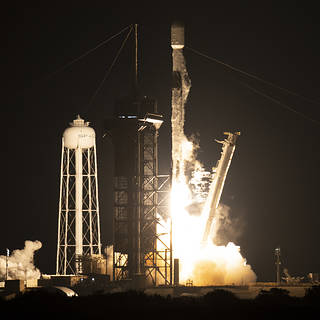Space Force mission blasts off from Florida after multiple delays
Thursday, 09 December 2021 12:13
Washington DC (UPI) Dec 7, 2021
 A mission overseen by the U.S. Space Force to send equipment into space aboard an Atlas V rocket lifted off from Florida early Tuesday after a delay of several days.
United Launch Alliance sent the Space Test Program-3 (STP-3) mission into space from Launch Complex 41 at the Cape Canaveral Space Force Station in Florida at about 5:19 a.m. EST Tuesday.
The mission lifted off carry
A mission overseen by the U.S. Space Force to send equipment into space aboard an Atlas V rocket lifted off from Florida early Tuesday after a delay of several days.
United Launch Alliance sent the Space Test Program-3 (STP-3) mission into space from Launch Complex 41 at the Cape Canaveral Space Force Station in Florida at about 5:19 a.m. EST Tuesday.
The mission lifted off carry
 A mission overseen by the U.S. Space Force to send equipment into space aboard an Atlas V rocket lifted off from Florida early Tuesday after a delay of several days.
United Launch Alliance sent the Space Test Program-3 (STP-3) mission into space from Launch Complex 41 at the Cape Canaveral Space Force Station in Florida at about 5:19 a.m. EST Tuesday.
The mission lifted off carry
A mission overseen by the U.S. Space Force to send equipment into space aboard an Atlas V rocket lifted off from Florida early Tuesday after a delay of several days.
United Launch Alliance sent the Space Test Program-3 (STP-3) mission into space from Launch Complex 41 at the Cape Canaveral Space Force Station in Florida at about 5:19 a.m. EST Tuesday.
The mission lifted off carry US Army tests multi-orbit solutions leveraging MEO capabilities amid SES's upcoming O3b mPOWER launch
Thursday, 09 December 2021 12:13
Reston VA (SPX) Dec 08, 2021
 SES Government Solutions (SES GS), a wholly-owned subsidiary of SES, supports the U.S. Army in conducting a series of cutting-edge trials and testing of commercial satellite constellations in multiple orbits, as well as services and ground terminals, in the U.S. Government's effort to establish Multi-Domain Operations (MDO) by 2028.
Most recently, the U.S. Army announced its integrated gro
SES Government Solutions (SES GS), a wholly-owned subsidiary of SES, supports the U.S. Army in conducting a series of cutting-edge trials and testing of commercial satellite constellations in multiple orbits, as well as services and ground terminals, in the U.S. Government's effort to establish Multi-Domain Operations (MDO) by 2028.
Most recently, the U.S. Army announced its integrated gro
 SES Government Solutions (SES GS), a wholly-owned subsidiary of SES, supports the U.S. Army in conducting a series of cutting-edge trials and testing of commercial satellite constellations in multiple orbits, as well as services and ground terminals, in the U.S. Government's effort to establish Multi-Domain Operations (MDO) by 2028.
Most recently, the U.S. Army announced its integrated gro
SES Government Solutions (SES GS), a wholly-owned subsidiary of SES, supports the U.S. Army in conducting a series of cutting-edge trials and testing of commercial satellite constellations in multiple orbits, as well as services and ground terminals, in the U.S. Government's effort to establish Multi-Domain Operations (MDO) by 2028.
Most recently, the U.S. Army announced its integrated gro First crew of space station provide a full update on China's progress
Thursday, 09 December 2021 12:13
Beijing (XNA) Dec 08, 2021
 The three astronauts involved in the Shenzhou XII mission have recovered well after their 3-month spaceflight and will return to regular training once related health assessments are completed.
Major General Jing Haipeng, another astronaut, said on Tuesday the post-spaceflight recovery period has three phases: isolation, convalescence and observation.
The three Shenzhou XII astronauts
The three astronauts involved in the Shenzhou XII mission have recovered well after their 3-month spaceflight and will return to regular training once related health assessments are completed.
Major General Jing Haipeng, another astronaut, said on Tuesday the post-spaceflight recovery period has three phases: isolation, convalescence and observation.
The three Shenzhou XII astronauts
 The three astronauts involved in the Shenzhou XII mission have recovered well after their 3-month spaceflight and will return to regular training once related health assessments are completed.
Major General Jing Haipeng, another astronaut, said on Tuesday the post-spaceflight recovery period has three phases: isolation, convalescence and observation.
The three Shenzhou XII astronauts
The three astronauts involved in the Shenzhou XII mission have recovered well after their 3-month spaceflight and will return to regular training once related health assessments are completed.
Major General Jing Haipeng, another astronaut, said on Tuesday the post-spaceflight recovery period has three phases: isolation, convalescence and observation.
The three Shenzhou XII astronauts LCO Scientists Confirm the Discovery of the First Moving Microlensing Arcs
Thursday, 09 December 2021 12:13
Goleta CA (SPX) Dec 09, 2021
 On April 18, 2019, the European Space Agency's Gaia Mission alerted astronomers worldwide to an unusually bright but fleeting celestial event: the gravitational microlensing event Gaia19bld. The temporary, chance alignment between two unrelated star systems produced twin images of the background star and gave scientists their first opportunity to actually observe the arc-shaped images move in re
On April 18, 2019, the European Space Agency's Gaia Mission alerted astronomers worldwide to an unusually bright but fleeting celestial event: the gravitational microlensing event Gaia19bld. The temporary, chance alignment between two unrelated star systems produced twin images of the background star and gave scientists their first opportunity to actually observe the arc-shaped images move in re
 On April 18, 2019, the European Space Agency's Gaia Mission alerted astronomers worldwide to an unusually bright but fleeting celestial event: the gravitational microlensing event Gaia19bld. The temporary, chance alignment between two unrelated star systems produced twin images of the background star and gave scientists their first opportunity to actually observe the arc-shaped images move in re
On April 18, 2019, the European Space Agency's Gaia Mission alerted astronomers worldwide to an unusually bright but fleeting celestial event: the gravitational microlensing event Gaia19bld. The temporary, chance alignment between two unrelated star systems produced twin images of the background star and gave scientists their first opportunity to actually observe the arc-shaped images move in re NASA Returns Hubble to Full Science Operations
Thursday, 09 December 2021 12:13
Washington DC (SPX) Dec 08, 2021
 NASA's Hubble Space Telescope team recovered the Space Telescope Imaging Spectrograph on Monday, Dec. 6, and is now operating with all four active instruments collecting science. The team has still not detected any further synchronization message issues since monitoring began Nov. 1.
The team will continue work on developing and testing changes to instrument software that would allow them
NASA's Hubble Space Telescope team recovered the Space Telescope Imaging Spectrograph on Monday, Dec. 6, and is now operating with all four active instruments collecting science. The team has still not detected any further synchronization message issues since monitoring began Nov. 1.
The team will continue work on developing and testing changes to instrument software that would allow them
 NASA's Hubble Space Telescope team recovered the Space Telescope Imaging Spectrograph on Monday, Dec. 6, and is now operating with all four active instruments collecting science. The team has still not detected any further synchronization message issues since monitoring began Nov. 1.
The team will continue work on developing and testing changes to instrument software that would allow them
NASA's Hubble Space Telescope team recovered the Space Telescope Imaging Spectrograph on Monday, Dec. 6, and is now operating with all four active instruments collecting science. The team has still not detected any further synchronization message issues since monitoring began Nov. 1.
The team will continue work on developing and testing changes to instrument software that would allow them China's lunar rover spots cube-like object on Moon, sparking curiosity
Thursday, 09 December 2021 12:13
Beijing (XNA) Dec 08, 2021
 The cube-like object spotted recently by China's lunar rover on the far side of the moon aroused wild curiosity in cyberspace worldwide this week.
Yutu 2, the lander and rover of the Chang'e 4 probe, captured an obscure but intriguing image about 80 meters from its location during the mission's 36th lunar day, according to Our Space, a Chinese science channel that published the machine's l
The cube-like object spotted recently by China's lunar rover on the far side of the moon aroused wild curiosity in cyberspace worldwide this week.
Yutu 2, the lander and rover of the Chang'e 4 probe, captured an obscure but intriguing image about 80 meters from its location during the mission's 36th lunar day, according to Our Space, a Chinese science channel that published the machine's l
 The cube-like object spotted recently by China's lunar rover on the far side of the moon aroused wild curiosity in cyberspace worldwide this week.
Yutu 2, the lander and rover of the Chang'e 4 probe, captured an obscure but intriguing image about 80 meters from its location during the mission's 36th lunar day, according to Our Space, a Chinese science channel that published the machine's l
The cube-like object spotted recently by China's lunar rover on the far side of the moon aroused wild curiosity in cyberspace worldwide this week.
Yutu 2, the lander and rover of the Chang'e 4 probe, captured an obscure but intriguing image about 80 meters from its location during the mission's 36th lunar day, according to Our Space, a Chinese science channel that published the machine's l Europe opens up a new space to commercial services
Thursday, 09 December 2021 11:02
ESA is calling on industry to come forward with ideas for crew and cargo transportation, operations, payloads, research, living quarters and even astronaut training. All of this could develop into new services in an effort to enlarge the space ecosystem to the commercial sphere.
Falcon 9 launches NASA X-ray astronomy satellite
Thursday, 09 December 2021 06:44
A SpaceX Falcon 9 launched a small NASA X-ray astronomy satellite Dec. 9 to study black holes and neutron stars, an “appetizer” for the launch later this month of the much larger James Webb Space Telescope.
Blood disc for astronaut diagnosis
Thursday, 09 December 2021 05:45 Image:
Blood disc for astronaut diagnosis
Image:
Blood disc for astronaut diagnosis NASA Launches New Mission to Explore Universe’s Most Dramatic Objects
Thursday, 09 December 2021 05:16 NASA’s Imaging X-ray Polarimetry Explorer (IXPE) mission launched at 1 a.m. EST Thursday on a SpaceX Falcon 9 rocket from NASA’s Kennedy Space Center in Florida.
NASA’s Imaging X-ray Polarimetry Explorer (IXPE) mission launched at 1 a.m. EST Thursday on a SpaceX Falcon 9 rocket from NASA’s Kennedy Space Center in Florida. Rocket Lab launches two BlackSky satellites, wins Synspective contract
Thursday, 09 December 2021 04:52
Rocket Lab launched another pair of BlackSky satellites Dec. 8, a day after the company won a contract from a Japanese firm for three launches of radar imaging satellites.
Mars helicopter flies again; encounters radio interference on 17th flight
Thursday, 09 December 2021 01:22
Pasadena CA (JPL) Dec 09, 2021
 Ingenuity flew for the 17th time at Mars on Sunday, Dec. 5. After the helicopter executed the planned 614-foot (187-meter) traverse to the northeast, the radio communications link between Ingenuity and the Perseverance Mars rover was disrupted during the final descent phase of the flight. Approximately 15 minutes later, Perseverance received several packets of additional Ingenuity telemetry indicating that the flight electronics and battery were healthy.
Ingenuity flew for the 17th time at Mars on Sunday, Dec. 5. After the helicopter executed the planned 614-foot (187-meter) traverse to the northeast, the radio communications link between Ingenuity and the Perseverance Mars rover was disrupted during the final descent phase of the flight. Approximately 15 minutes later, Perseverance received several packets of additional Ingenuity telemetry indicating that the flight electronics and battery were healthy.
 Ingenuity flew for the 17th time at Mars on Sunday, Dec. 5. After the helicopter executed the planned 614-foot (187-meter) traverse to the northeast, the radio communications link between Ingenuity and the Perseverance Mars rover was disrupted during the final descent phase of the flight. Approximately 15 minutes later, Perseverance received several packets of additional Ingenuity telemetry indicating that the flight electronics and battery were healthy.
Ingenuity flew for the 17th time at Mars on Sunday, Dec. 5. After the helicopter executed the planned 614-foot (187-meter) traverse to the northeast, the radio communications link between Ingenuity and the Perseverance Mars rover was disrupted during the final descent phase of the flight. Approximately 15 minutes later, Perseverance received several packets of additional Ingenuity telemetry indicating that the flight electronics and battery were healthy. Soyuz docks at ISS with three onboard
Thursday, 09 December 2021 01:22
Baikonur, Kazakhstan (AFP) Dec 8, 2021
 A Russian rocket carrying a Japanese billionaire docked with the International Space Station on Wednesday, marking the country's return to space tourism after a decade-long pause that saw the rise of competition from the United States.
Online fashion tycoon Yusaku Maezawa and his assistant Yozo Hirano blasted off from the Baikonur cosmodrome in Kazakhstan earlier on Wednesday.
They dock
A Russian rocket carrying a Japanese billionaire docked with the International Space Station on Wednesday, marking the country's return to space tourism after a decade-long pause that saw the rise of competition from the United States.
Online fashion tycoon Yusaku Maezawa and his assistant Yozo Hirano blasted off from the Baikonur cosmodrome in Kazakhstan earlier on Wednesday.
They dock
 A Russian rocket carrying a Japanese billionaire docked with the International Space Station on Wednesday, marking the country's return to space tourism after a decade-long pause that saw the rise of competition from the United States.
Online fashion tycoon Yusaku Maezawa and his assistant Yozo Hirano blasted off from the Baikonur cosmodrome in Kazakhstan earlier on Wednesday.
They dock
A Russian rocket carrying a Japanese billionaire docked with the International Space Station on Wednesday, marking the country's return to space tourism after a decade-long pause that saw the rise of competition from the United States.
Online fashion tycoon Yusaku Maezawa and his assistant Yozo Hirano blasted off from the Baikonur cosmodrome in Kazakhstan earlier on Wednesday.
They dock Blue Origin flight with Alan Shephard daughter delayed by weather
Thursday, 09 December 2021 01:22
Washington (AFP) Dec 8, 2021
 A Blue Origin flight due to include the daughter of the first American to travel to space has been delayed by two days because of forecasts of bad weather, the company said Wednesday.
The flight was originally scheduled for Thursday but because of winds forecast for both that day and Friday it will now aim to lift off on Saturday at 8:45 am (1445 GMT) from West Texas.
Laura Shepard Churc
A Blue Origin flight due to include the daughter of the first American to travel to space has been delayed by two days because of forecasts of bad weather, the company said Wednesday.
The flight was originally scheduled for Thursday but because of winds forecast for both that day and Friday it will now aim to lift off on Saturday at 8:45 am (1445 GMT) from West Texas.
Laura Shepard Churc
 A Blue Origin flight due to include the daughter of the first American to travel to space has been delayed by two days because of forecasts of bad weather, the company said Wednesday.
The flight was originally scheduled for Thursday but because of winds forecast for both that day and Friday it will now aim to lift off on Saturday at 8:45 am (1445 GMT) from West Texas.
Laura Shepard Churc
A Blue Origin flight due to include the daughter of the first American to travel to space has been delayed by two days because of forecasts of bad weather, the company said Wednesday.
The flight was originally scheduled for Thursday but because of winds forecast for both that day and Friday it will now aim to lift off on Saturday at 8:45 am (1445 GMT) from West Texas.
Laura Shepard Churc Russia's cosmos town, an isolated relic of Soviet glory
Thursday, 09 December 2021 01:22
Baikonur, Kazakhstan (AFP) Dec 8, 2021
 Malik Mutaliyev walks by an abandoned amusement park in wintry Baikonur, a secretive town in Kazakhstan's inhospitable steppe that appeared alongside the eponymous Baikonur Cosmodrome where the Soviet Union's space programme rose to glory.
"Our town has lived through a lot: Perestroika, the fall of the Soviet Union, electricity shortages. We've been through it all," says the 67-year-old form
Malik Mutaliyev walks by an abandoned amusement park in wintry Baikonur, a secretive town in Kazakhstan's inhospitable steppe that appeared alongside the eponymous Baikonur Cosmodrome where the Soviet Union's space programme rose to glory.
"Our town has lived through a lot: Perestroika, the fall of the Soviet Union, electricity shortages. We've been through it all," says the 67-year-old form
 Malik Mutaliyev walks by an abandoned amusement park in wintry Baikonur, a secretive town in Kazakhstan's inhospitable steppe that appeared alongside the eponymous Baikonur Cosmodrome where the Soviet Union's space programme rose to glory.
"Our town has lived through a lot: Perestroika, the fall of the Soviet Union, electricity shortages. We've been through it all," says the 67-year-old form
Malik Mutaliyev walks by an abandoned amusement park in wintry Baikonur, a secretive town in Kazakhstan's inhospitable steppe that appeared alongside the eponymous Baikonur Cosmodrome where the Soviet Union's space programme rose to glory.
"Our town has lived through a lot: Perestroika, the fall of the Soviet Union, electricity shortages. We've been through it all," says the 67-year-old form 
